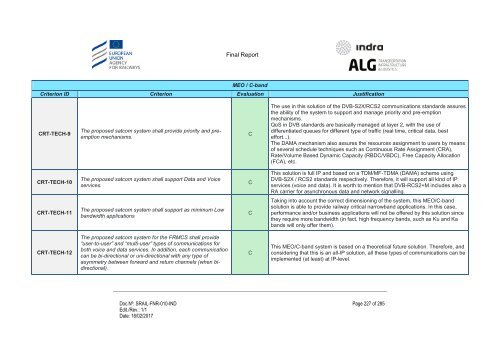Study on feasibility of SATCOM for railway communication
SRAIL-FNR-010-IND%20-%20FinalReport_v1.1_20170216
SRAIL-FNR-010-IND%20-%20FinalReport_v1.1_20170216
You also want an ePaper? Increase the reach of your titles
YUMPU automatically turns print PDFs into web optimized ePapers that Google loves.
Final Report<br />
MEO / C-band<br />
Criteri<strong>on</strong> ID Criteri<strong>on</strong> Evaluati<strong>on</strong> Justificati<strong>on</strong><br />
CRT-TECH-9<br />
The proposed satcom system shall provide priority and preempti<strong>on</strong><br />
mechanisms.<br />
C<br />
The use in this soluti<strong>on</strong> <strong>of</strong> the DVB-S2X/RCS2 communicati<strong>on</strong>s standards assures<br />
the ability <strong>of</strong> the system to support and manage priority and pre-empti<strong>on</strong><br />
mechanisms.<br />
QoS in DVB standards are basically managed at layer 2, with the use <strong>of</strong><br />
differentiated queues <strong>for</strong> different type <strong>of</strong> traffic (real time, critical data, best<br />
ef<strong>for</strong>t...).<br />
The DAMA mechanism also assures the resources assignment to users by means<br />
<strong>of</strong> several schedule techniques such as C<strong>on</strong>tinuous Rate Assignment (CRA),<br />
Rate/Volume Based Dynamic Capacity (RBDC/VBDC), Free Capacity Allocati<strong>on</strong><br />
(FCA), etc.<br />
CRT-TECH-10<br />
The proposed satcom system shall support Data and Voice<br />
services.<br />
C<br />
This soluti<strong>on</strong> is full IP and based <strong>on</strong> a TDM/MF-TDMA (DAMA) scheme using<br />
DVB-S2X / RCS2 standards respectively. There<strong>for</strong>e, it will support all kind <strong>of</strong> IP<br />
services (voice and data). It is worth to menti<strong>on</strong> that DVB-RCS2+M includes also a<br />
RA carrier <strong>for</strong> asynchr<strong>on</strong>ous data and network signalling.<br />
CRT-TECH-11<br />
The proposed satcom system shall support as minimum Low<br />
bandwidth applicati<strong>on</strong>s<br />
C<br />
Taking into account the correct dimensi<strong>on</strong>ing <strong>of</strong> the system, this MEO/C-band<br />
soluti<strong>on</strong> is able to provide <strong>railway</strong> critical narrowband applicati<strong>on</strong>s. In this case,<br />
per<strong>for</strong>mance and/or business applicati<strong>on</strong>s will not be <strong>of</strong>fered by this soluti<strong>on</strong> since<br />
they require more bandwidth (in fact, high frequency bands, such as Ku and Ka<br />
bands will <strong>on</strong>ly <strong>of</strong>fer them).<br />
CRT-TECH-12<br />
The proposed satcom system <strong>for</strong> the FRMCS shall provide<br />
“user-to-user” and “multi-user” types <strong>of</strong> communicati<strong>on</strong>s <strong>for</strong><br />
both voice and data services. In additi<strong>on</strong>, each communicati<strong>on</strong><br />
can be bi-directi<strong>on</strong>al or uni-directi<strong>on</strong>al with any type <strong>of</strong><br />
asymmetry between <strong>for</strong>ward and return channels (when bidirecti<strong>on</strong>al).<br />
C<br />
This MEO/C-band system is based <strong>on</strong> a theoretical future soluti<strong>on</strong>. There<strong>for</strong>e, and<br />
c<strong>on</strong>sidering that this is an all-IP soluti<strong>on</strong>, all these types <strong>of</strong> communicati<strong>on</strong>s can be<br />
implemented (at least) at IP-level.<br />
Doc.Nº: SRAIL-FNR-010-IND<br />
Edit./Rev.: 1/1<br />
Date: 16/02/2017<br />
Page 227 <strong>of</strong> 285


